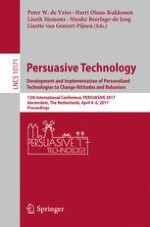2017 | OriginalPaper | Buchkapitel
Investigation of Social Predictors of Competitive Behavior in Persuasive Technology
verfasst von : Kiemute Oyibo, Julita Vassileva
Erschienen in: Persuasive Technology: Development and Implementation of Personalized Technologies to Change Attitudes and Behaviors
Aktivieren Sie unsere intelligente Suche, um passende Fachinhalte oder Patente zu finden.
Wählen Sie Textabschnitte aus um mit Künstlicher Intelligenz passenden Patente zu finden. powered by
Markieren Sie Textabschnitte, um KI-gestützt weitere passende Inhalte zu finden. powered by
